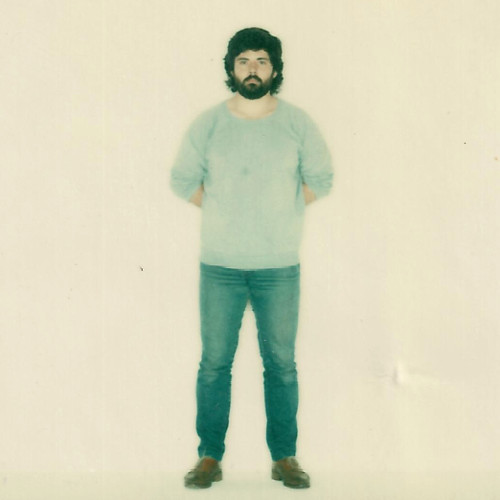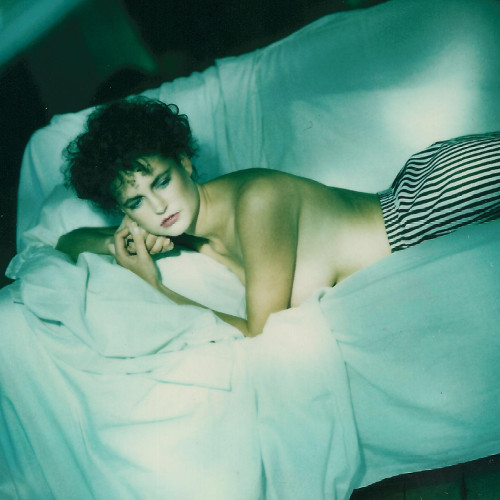
Session Hairstylist: Ian (me). Photographer: Chris Roberts. Hard at work light-testing 01:10:1981. Polaroid. Before digital cameras we collected Polaroids like Yu-Gi-Oh cards.
Becoming a session hairstylist
My first photographic session ever, was as Robert Lobetta’s junior when I worked at Ricci Burns – Over 21 magazine (1973). Photographer Willie Christie.
My first photographic session as a hairstylist (flying solo) was for Woman and Home magazine (1974) – No photo credits, just a fee of ten quid (about a hundred pounds today 2015). Actually, I was still a junior and about two months away from becoming a hairstylist!
…What happened was: Oliver, the manager of Ricci Burns, King’s Road, went around the salon, stylist to stylist, starting from Robert, asking if they wanted to do a photo-session after work that night – it was a Friday! Everyone was saying no because they were going out!
When Ollie finally asked me, out of utter desperation (because he obviously didn’t want to do it either), I said yes, and I was totally over the fucking moon. I was deliriously happy and unusually nervous, even though I’d assisted on countless photo-sessions. Ollie said, “Don’t tell them you’re a junior!” Robert said, “I’ll kill you if you lose it.” (I’d borrowed his session bag!)
About a week after the Woman and Home session, Ollie came over to me and said, “I’d like you to do a fashion show for Coco (a Chelsea boutique) tomorrow and by-the-way, Penny Ryder phoned to say that Woman and Home loved your work.”
So, is that how to become a session hairstylist? Join a noted London salon and train with the world’s best hairstylists?
No, there’s more to it than that, you’ve got to really want to be a session hairstylist, because there’s quite a lot of shit.
Get your name out there
In this age of connectivity, I think most of us know the power of social networking sites like Facebook, Twitter, Linkedin and Instagram coupled with owning a Website and having an email mailing-list. However, the one brilliant thing about hairdressers is our wonderful ability to do face-to-face.
When I first went freelance I decided to hawk my portfolio around to the magazines and the photographers that I’d worked with while at Ricci’s. And I thought that I may as well start with Brides magazine – Vogue House!
The assistant editor came out of her office and I stood to attention. She shook my outstretched hand and abruptly tore my portfolio from the other, and walked straight back into her chaotic office, opening the portfolio as she went – Out fell: a brown A4 envelope containing a number of contact sheets, half a dozen loose colour transparencies in their plastic and glass frames, three business cards and a scrappy piece of paper with a few scribbled notes for my eyes only! I frantically picked up the embarrassing spillage. In the meantime, the assistant editor had unceremoniously dumped my portfolio on her desk and flipped through its twelve pages faster than she could say, “Not Interested” and returned to the door while zipping-up the portfolio saying, “We’ll contact you – Goodbye.” I put the paraphernalia into the brown envelope, retrieved my portfolio, handed her a card and found myself on the other side of the door. The whole thing, which I laughingly call an interview, took about thirty seconds – and that’s being generous!
I was completely nonplussed and felt pretty dejected, my thick skin wore very thin that day.
Ages later the assistant editor phoned and asked me to do a last minute, “no credits, no fee,” photo session with the American fashion photographer Arthur Elgort with whom I’d worked before – awesome.
Never underestimate the super-human ability of a frantically busy, seasoned professional – I was so naive because I’d been mollycoddled by a salon, Ricci Burns.
Maybe life would have been a lot simpler if I’d joined a specialist agency for freelance session hairstylists – And maybe not?
The horrid truth – Move To London!
The fashion industry is London centric and I think it will be (for lots of reasons) for the next fifty years. A legacy of post war Britain, the Swinging Sixties and the art, film and music industries.
Obviously there are opportunities for session hairstylists in the major cities and provinces, but the focus is in London! #LondonFashionWeek?

Photographer: Chris Roberts. Model Cassie. Hair & make-up Ian (me). Richard’s studio 06:02:1982. Test Session Polaroid.
Build a portfolio by doing Test Sessions
If you’re a n00bie/wannabe session hairstylist: a test session is where a photographer, model, make-up artist and hairdresser (occasionally also: stylist and fashion designer) come together to create a photograph. A photograph that can be included in their portfolios.
Participating in a test session is the best way to start your journey to becoming a session hairstylist. Session work is all about teamwork – When a group of talented creatives with big personalities come together, something extraordinary usually happens; and when the buzz is right the results can be mind-blowingly sensational. But I hope you can also imagine what it’s like when things are not so awesome? Yeah, that’s what test sessions are partly for: understanding creative teamwork!
Test sessions are also magnificent for building connections and relationships; for instance, most of the young photographers you test with will be assistant fashion photographers: Chris Roberts (who I did about three years of photographic sessions with) was assistant to Willie Christie and Patrick Lichfield – And you’d be surprised how far their networks spread.
On the other hand, you might test with someone like Charlie Kemp, he wasn’t an assistant, his wife Maril was a top model with Laraine Ashton. Charlie and I did a lot of testing together throughout the 1980s, he specialised in portfolio work, and he knew everyone – we spent too much time in the pub – he taught me a lot.
Hitting Paydirt
When you’re standing behind a model in a tiny cupboard with a massive mirror and an arc lamp burning the back of your neck and the ridiculous advertorial that the newspaper is laughably calling a fashion feature actually represents an artistic boundary that you said you wouldn’t cross in a billion years, but you’ve got ten jobs exactly the same lined up for next week.
You’ll know when you’ve hit paydirt when Vogue fashion editor Alexandra Shulman gives you a ring!
And BTW, it’s a very, very small world.
